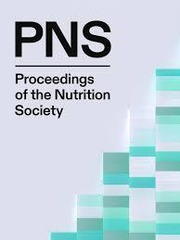No CrossRef data available.
Article contents
Associations between the EAT-Lancet Index, food group consumption and Eatwell Guide adherence in UK adults
Published online by Cambridge University Press: 09 October 2025
Abstract
The EAT-Lancet Commission’s “Planetary Health Diet” (PHD) aims to optimise population health and environmental sustainability by promoting a plant-forward diet with animal products consumed in moderation(1). The UK’s Eatwell Guide provides recommendations for key nutrients and food groups to achieve a healthy, balanced diet; greater adherence is associated with environmental benefits(2). This secondary analysis examines the relationships between PHD adherence, food group intakes and compliance with the Eatwell Guide in UK adults.
Data from disease-free UK adults aged ≥18 years (n=452) were pooled from five cross- sectional analyses that recorded habitual dietary intake using the eNutri food frequency questionnaire, which generated nutrient and food group data(3). EAT-Lancet Index scores were calculated(4) for each participant then stratified into quartiles (Q), with the highest scores in Q4 (representing greater adherence to the PHD). Adherence to the 9 Eatwell Guide recommendations were determined for each quartile then classified as ‘very low’ (0– 2 recommendations met), ‘low’ (3–4) or ‘intermediate-to-high’ (5–9) (2). ANCOVA (adjusted for sex, age, physical activity, ethnicity, employment status, and body mass index (BMI)) compared the mean daily intakes of 17 food groups across quartiles. If significant, pairwise comparisons with Bonferroni correction were determined. P values ≤0.01 were considered significant for all.
Study participants had a mean (SD) age of 44 (19) years and a BMI of 25.7 (6.0) kg/m2 and 79.6% were female. Adherence to the Eatwell Guide was very low in Q1 and Q2, low in Q3 and intermediate-to-high in Q4 (where 5 out of the 9 recommendations were met).
Compared to Q1, higher adherence to the PHD (Q4) was associated with higher intakes of ‘fruits and vegetables’ (+408 g/d), ‘pulses’ (+25.0 g/d), ‘whole grains’(+29.2 g/d), ‘nuts and seeds’(+15.8 g/d) ‘plant-based meat alternatives’ (+14.3 g/d) and ‘plant-based dairy alternatives’ (+110 g/d) (all p≤0.001). In contrast, Q4 had lower intakes of ‘eggs’ (-17.0 g/d), ‘potatoes’(-50.5 g/d), ‘poultry’ (-38.1 g/d), ‘red meat’(-40.4 g/d), ‘processed meat’(-22.5 g/d), ‘refined grains’ (-65.0 g/d) and ‘dairy products’ (-110 g/d) relative to Q1 (all p≤0.001). Although intakes of ‘unsaturated fats and oils’ and ‘fish and other seafood’ were highest in Q4, neither was significantly different from the other quartiles.
Greater adherence to the PHD was associated with higher intakes of plant-based foods (including a two-fold higher intake in fruits and vegetables), and lower consumption of animal products, notably a five-fold lower intake of red meat. Moreover, UK adults whose diets more closely reflected the PHD also met a higher proportion of Eatwell Guide recommendations. These findings suggest that closer adherence to the PHD aligns with greater compliance to UK dietary guidelines (Eatwell Guide), reflecting a more favorable dietary pattern.
Information
- Type
- Abstract
- Information
- Proceedings of the Nutrition Society , Volume 84 , Issue OCE4: Nutrition Society Conference 2025, 1-2 July 2025 , August 2025 , E289
- Copyright
- © The Author(s), 2025. Published by Cambridge University Press on behalf of The Nutrition Society


